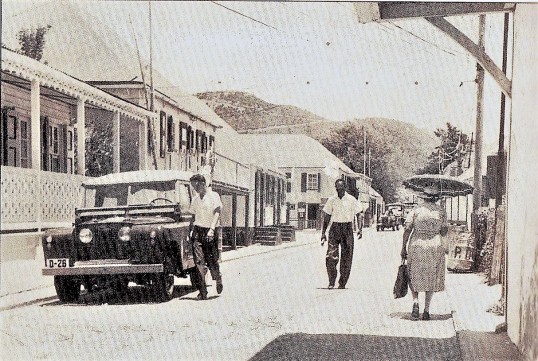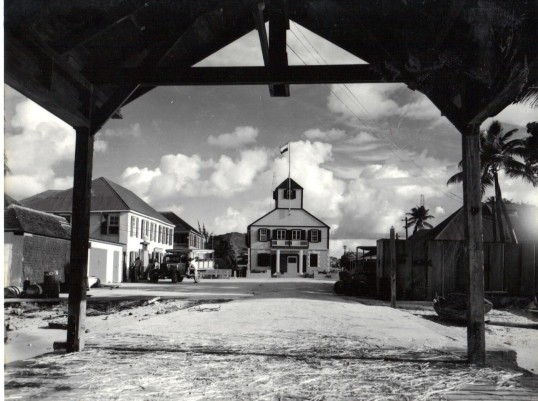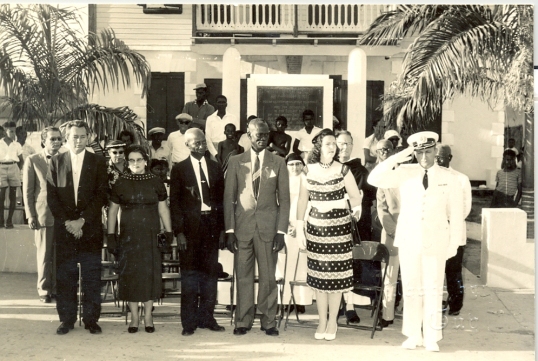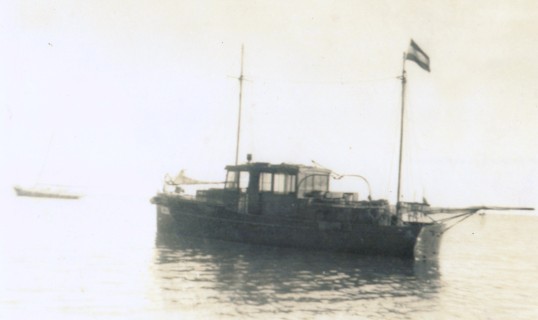THE OLD COURT HOUSE
THE OLD COURTHOUSE
By Will Johnson.

The Court-house from around 1900.
A few weeks ago, when returning to Saba two ladies approached me at the Juliana airport. They were accompanied by a Dutch man whom I later understood to be a Judge. Me and Judge’s never sat horses but I was polite to them. The ladies were full of praise for my column ‘Under the Sea Grape Tree’. At the end of the conversation they said to me. When do you plan to write an article about the ‘Old Courthouse’?
Of course, I have referred to it a number of times. I have happy memories of the place as I worked there from 1960 to 1966. That was the year for a major restoration and our office was moved further up street. The Receivers Office that is and the Post Office was moved to the Back Street.
My boss was Joseph Alphonse Constantine O’Connor whom I have written about in a separate article. We also had Jimmy Halley, Laurel Peterson, Arnold Scot and the two postmen Sonny Boy Lake and Whitfield ‘Feely” Vlaun . We also had the Curacao Bank there and Mrs. Constant Williams worked there. Sydney Lejuez was in a customs uniform at the time and issued documents for packages being sent to Aruba and Curacao. He also gave clearances to the few ships which visited the island back then. It was mostly a few cargo schooners and sloops bringing in produce from as far as Puerto Rico.

WILL Johnson and Arnold Scot going to lunch. Worked in the Court-House. Photo from 1960 by Vincent Doncher
Lorenzo de Lain would come around to ring the bell, and Maurice Lake (Mooch) as well. I have written about them in other articles. Upstairs in the building would be used by the Court when it was in session but that was very rarely. The Notary which was my boss at the time and later Notary Jose Speetjens would use upstairs as their office to pass deeds. Also, the Island Council of the Windward Islands would meet upstairs. When I spoke there, I thought it would be a good idea to challenge the system by basing my speech on “I am here to bury Caesar, not to praise him.” Well later in the day the news was all over town “Lord, what that little fellow did to poor Mr. Wathey. He said that he had come to bury him.” Mind you no such thing had crossed my mind.

On the left the Shell gas station of Mr. Cyrus Wilberforce Wathey after whom the square was named in the nineteen sixties.
When the American Consul visited the island she or he would work upstairs and meet the few U.S. citizens. Fons told me once much to his regret later that I should assist the Council as “HE” would not know many of the locals who had U.S. nationality. Fons was late that morning. When I went upstairs to see what I could do to help the Consul, lo and behold there was a beautiful young lady sitting there. I thought to myself; He must have brought his Secretary along,’. But when I asked her politely when was the Consul coming? She looked at me and said: “I am representing the Consul.” After all these years I still remember her name. But prefer to leave that tidbit of information behind. What I can divulge is that when Fons made his usual rounds at Pasangrahan Hotel, he looked surprised at me sitting there having dinner with a good-looking young lady. The man was my boss mind you. Respect. He came over to the table to ask me if I had seen the American Consul. An excuse of course to find out who the beautiful young lady was. When I told him “This is the Consul” I thought he would have fainted. She was a redhead, an expressed favorite type of gal for him. Anyway, nothing doing, I said to myself “if I have to lose my job, so be it, but I am not backing down for Fons.” Anyway he retreated. Not gracefully, but a retreat nevertheless. He never said anything on the job to me of course. But when he was out on the town and we met up he would insinuate what he would do to me if that ever happened again. His bad luck was that all of the future consuls were men and Fons was a lady’s man. Anyway, before the lady left, she told me to bring my passport and she stamped a BI/B2 visa in it. This came in very handy for me when I needed to travel to the USA.

Former view from the Court-house with the Blue Peter and Saba in the foreground. Photo from around 1950.
But I started out saying I was going to write about the Courthouse.
Whenever the library needs to get rid of old books Mrs. Joanna Simmons-Peterson calls me. Despite the fact that my house is full to overrunning with books I am always in the market for more. Just last week she brought me a few, one of which is ‘Caribbean Traditional Architecture” by Joan D. van Andel. She quotes Temminck Groll who did extensive studies on many of the buildings on the three Dutch Windward Islands. Also Dr. J. Hartog who wrote about the Court House.
“Around the year 1790, W.H. Rink LLD, who had just been appointed Commander of St. Martin, conceived a plan to build a Court House. A marble plaque commemorating the fact that Rink had had the Court House built by as early as 1793 demonstrates that he acted energetically. On the plaque (originally in Dutch), not only Rink’s name occurs but also those of the other founders, the councilors R.F. Muller, H. Godet, I. Pantophlet, A. van Heijningen, and A. Cannegieter.

The old scale house was removed in 1937 when the new Police Station was built in the alley next to the Court -house and bounding the Back Street.
The imposing Court-house, situated centrally on the former De Ruyter Square, is not just one of the important traditional buildings in Philipsburg, but has always played an essential part in the lives of the inhabitants of Philipsburg; formerly as a meeting place for the council, today as law court and Post office [1985].
The building is the best-known example of the traditional architecture of St. Martin, owing to its traditional form, its position in the history of the island and to the fact that nowadays her image figures on stamps, as well as on posters, advertising matter, book covers, note-books etc. It has more or less become the trademark, the signature of St. Martin.
The square on which the Court-House is situated, was originally a quiet and peaceful square. On the sea side the square was enclosed by a building which was used as a police station until 1937. It was referred to as the ‘Scale House.’ In that year, a new police station was built almost behind the Court Hose and the old building dismantled. The square then extended to the sea. One had a clear view of the square from the sea. Everyone mooring in Great Bay when rowing to the quay is at once struck by the picturesque sight of the square with the Court-House in the background. Until 1969 the view of the Court House was still partially obstructed by two monuments. One monument commemorating Princess Juliana’s visit in 1944, and the other in memory of those ‘killed in action’ in the second World War. After renovations to the Court-House were completed in 1969, those monuments were moved to the South side of the square.

This photo is from around 1890 or so.
To acquire a better insight into the architecture of the present Court-House, it is necessary to give some information about the first plan, the readjustments and the repairs to the building. In 1790 when Rink started his work as Commander, there was no accommodation for him in his function. He had to work in his own house and during this period the council also met in the Commander’s house. Rink considered this an unacceptable situation. A building was necessary not only for the governing activities of the island, but also for a prison.
Before starting to build, he had to obtain permission and money from the Dutch West-Indies Company. However, in 1791 the company was wound up and permission had to be acquired from the state of The Netherlands. It is unknown whether Rink was ever granted permission, but he did finance the building with money from the government treasury. For the planning, Rink appointed the surveyor John Handleigh, who acted both as architect and contractor. The ‘Long Wall’ had also been built under Handleigh’s supervision. The present day Court-House differs from Handleigh’s design. Many alterations have been made to the building since its completion in 1793.

View of the Court-House from one of the salt lots where the salt was piled up for sale to ships from Nova Scotia and schooners from Saba.
De Hartog gives an extensive description of the plan.
“The drawing shows a handsomely spacious building, with two floors, built in a representative manner, with a balcony built in the second storey over its full width. The walls made of stone were 18 inches thick. One entered the building through a small lobby, and reached in very first place the weigh-house or weighing room (later on the public portion of the Post Office). The council hall was located above the weighing room; in the lobby was the staircase for the Commander and members of the council. On Public occasions the entire Council could make its appearance on the spacious balcony.

The old Court House being dismantled in 1966. The architect was my friend Jan [A.J.C. Brouwer] The contractor was a Portuguese from Curacao. Carvallo I think his name was and he built the Police station on Saba as well.
The jail was located below the Secretariat and consisted of two large and three small cells.
The building was built in a period when St. Martin was prospering. The economic situation was favorable for financing a building of approximately 10.000 guilders. But in 1819, the Court-house was destroyed by a hurricane. The roof and the top floor were swept away. A restoration was not possible until 1826.
The converting and partial rebuilding of 1826 was the most radical in the history of the building. The new building was designed by Samuel Fahlberg [a Swede from St. Barth’s] . He was a cartographer, meteorologist, civil engineer, physician, artist and Council member.

Here are some of the legendary people of St. Martin gathered here for either St. Martin’s day or Queens Birthday. From left to right. Then Commissioner Claude Wathey and his wife Eva, then Milton Peters [Commissioner], after him Island Council Member Lionel Bernard Scot followed by Mrs. Hertha Baujon-Pietersz, behind her Father Bruno Boradori, then Lt. Governor J.J.Beaujon, and behind him Clem Labega and Alexis Arnell.
In January 1966, nearly one hundred years after the last radical restoration, the building had to be repaired and renovated again. This restoration had been planned since 1964. Jan Jacob Beaujon, then Lieutenant-Governor, requested A.J.C. Brouwer, head of the Technical Department of the Central Government, to make a plan for renewing the Court-house. The restoration was finished in 1969 and cost f.303.500. The restoration was executed on the condition that no changes were to be made to the exterior of the building.
The wooden top floor was pulled down and rebuilt in stone. Then a wooden weather boarding was fixed to the wall, so that the exterior of the building remained the same. By mistake, the floor was built 23 cm higher.The contractor had not kept to the architects plans. He had added three layers of concrete to the walls. The architect left the unintended change for what it was, as he thought the building had improved visually.
The tower was renewed and rebuilt using concrete; a carillon of twenty-five bells was installed in it. On the largest bell, the names of the Lt. Governors since 1951 were engraved.

The key to the Old Court-house. By the book under the key I swear not to give it to anyone.
When comparing the original Court-house with Fahlberg’s design, it is striking that visually the building has improved. The Belfry has given the official building a more monumental look; the square now appears more to its full advantage. Moreover, narrowing of the balcony and the addition of the belfry, a vertical counter balance to the horizontal look of the facade has been created.”
When we were moving to our new location further up the street, as I was leaving the Court-House I saw a key lying on the ground. It was the key to the building. I asked Fons if I could have it and he said it was O.K. With all my moving around I still have it and a photo and a series of old photos of the Courthouse will accompany this article. Recently Captain Eddy Hodge of Winair told me:” Man Will, you killing me with all this history. I learn more from you than all of that which I had in school.’ This one is for you Eddy.
Enjoy.


















